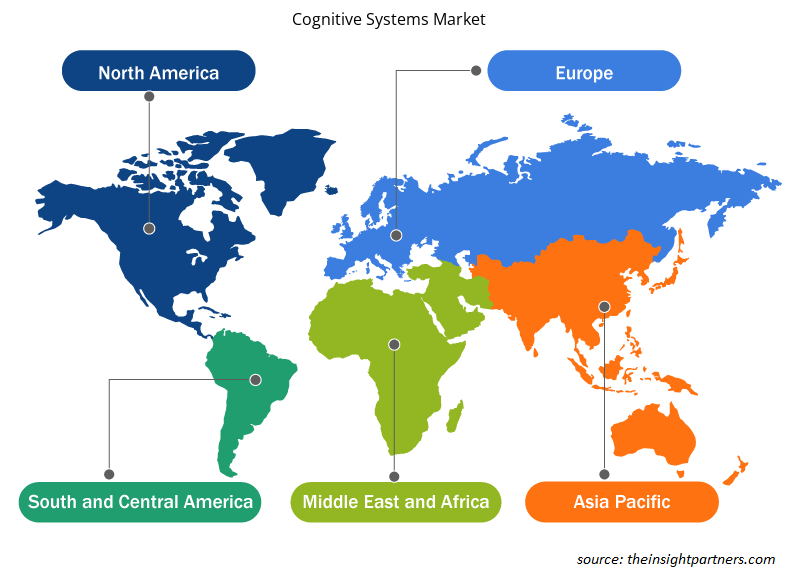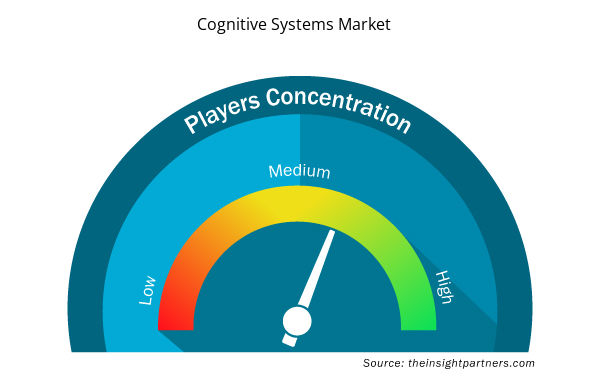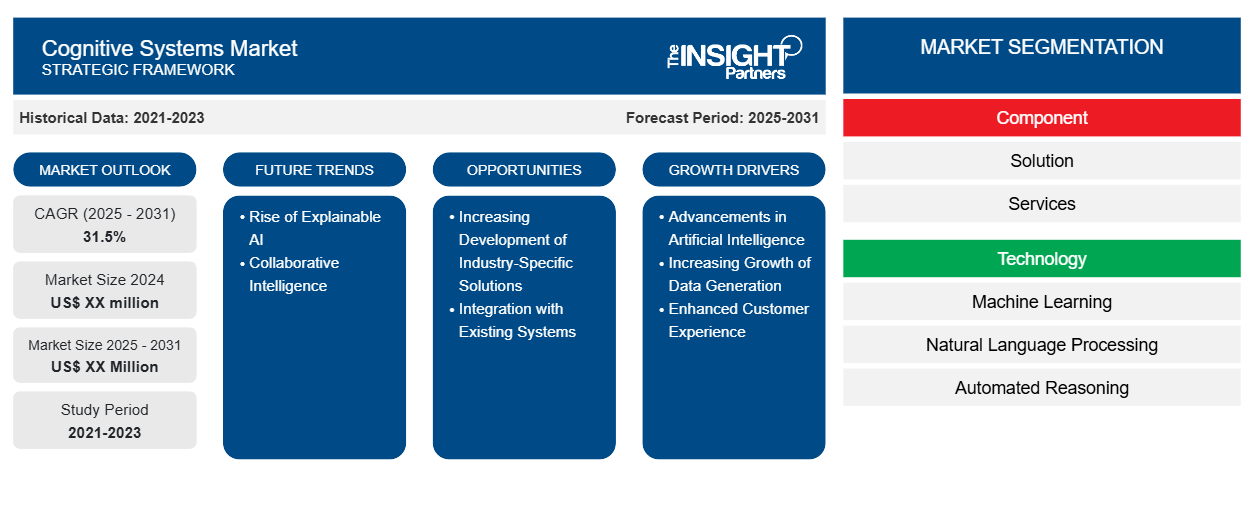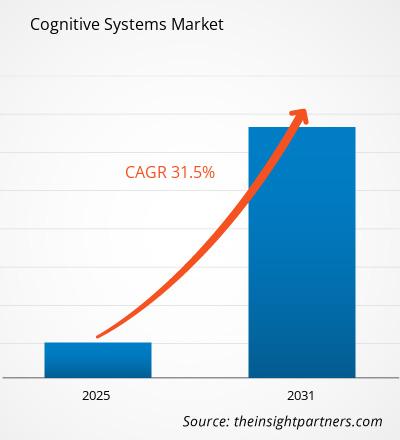من المتوقع أن يسجل سوق الأنظمة المعرفية معدل نمو سنوي مركب بنسبة 31.5٪ من عام 2023 إلى عام 2031، مع توسع حجم السوق من XX مليون دولار أمريكي في عام 2023 إلى XX مليون دولار أمريكي بحلول عام 2031.
تم تقسيم التقرير حسب المكون (الحل، الخدمات)؛ التكنولوجيا (التعلم الآلي، معالجة اللغة الطبيعية، التفكير الآلي، أخرى)؛ حجم المؤسسة (الشركات الصغيرة والمتوسطة، الشركات الكبيرة)؛ نوع النشر (السحابة، في الموقع)؛ المستخدم النهائي (الخدمات المصرفية والمالية والتأمين، الرعاية الصحية، التجزئة، تكنولوجيا المعلومات والاتصالات، أخرى). تم تقسيم التحليل العالمي بشكل أكبر على المستوى الإقليمي والدول الرئيسية. يقدم التقرير القيمة بالدولار الأمريكي للتحليل والشرائح المذكورة أعلاه
غرض التقرير
يهدف تقرير سوق الأنظمة المعرفية الصادر عن The Insight Partners إلى وصف المشهد الحالي والنمو المستقبلي وأهم العوامل الدافعة والتحديات والفرص. وسيوفر هذا رؤى لمختلف أصحاب المصلحة في الأعمال التجارية، مثل:
- مزودي/مصنعي التكنولوجيا: لفهم ديناميكيات السوق المتطورة ومعرفة فرص النمو المحتملة، وتمكينهم من اتخاذ قرارات استراتيجية مستنيرة.
- المستثمرون: إجراء تحليل شامل للاتجاهات فيما يتعلق بمعدل نمو السوق، وتوقعات السوق المالية، والفرص المتاحة عبر سلسلة القيمة.
- الهيئات التنظيمية: لتنظيم السياسات ومراقبة الأنشطة في السوق بهدف تقليل الانتهاكات والحفاظ على ثقة المستثمرين ودعم سلامة السوق واستقرارها.
تجزئة سوق الأنظمة المعرفية
عنصر
- حل
- خدمات
تكنولوجيا
- التعلم الآلي
- معالجة اللغة الطبيعية
- الاستدلال الآلي
- آحرون
حجم المؤسسة
- الشركات الصغيرة والمتوسطة
- الشركات الكبيرة
نوع النشر
- سحاب
- في الموقع
نوع النشر
- سحاب
- في الموقع
قم بتخصيص هذا التقرير ليناسب متطلباتك
ستحصل على تخصيص لأي تقرير - مجانًا - بما في ذلك أجزاء من هذا التقرير، أو تحليل على مستوى الدولة، وحزمة بيانات Excel، بالإضافة إلى الاستفادة من العروض والخصومات الرائعة للشركات الناشئة والجامعات
- احصل على أهم اتجاهات السوق الرئيسية لهذا التقرير.ستتضمن هذه العينة المجانية تحليلاً للبيانات، بدءًا من اتجاهات السوق وحتى التقديرات والتوقعات.
عوامل نمو سوق الأنظمة المعرفية
- التطورات في الذكاء الاصطناعي: إن التطورات السريعة في تقنيات الذكاء الاصطناعي هي المحرك الأساسي لسوق الأنظمة المعرفية. إن الابتكارات في التعلم الآلي والتعلم العميق ومعالجة اللغة الطبيعية تمكن الأنظمة المعرفية من تحليل كميات هائلة من البيانات والتعلم من الأنماط واتخاذ قرارات مستنيرة. وتمكن هذه القدرة المؤسسات من تعزيز كفاءتها التشغيلية وتحسين تفاعلاتها مع العملاء ودفع الابتكار. ومع إدراك الشركات بشكل متزايد لقيمة الذكاء الاصطناعي في تحويل العمليات والحصول على مزايا تنافسية، يستمر الطلب على الأنظمة المعرفية في النمو، مما يدفع السوق إلى التوسع.
- النمو المتزايد في توليد البيانات: إن النمو الهائل للبيانات التي يتم توليدها من مصادر مختلفة، بما في ذلك أجهزة إنترنت الأشياء، ووسائل التواصل الاجتماعي، وتطبيقات المؤسسات، يشكل محركًا مهمًا لسوق الأنظمة المعرفية. وتسعى المؤسسات إلى إيجاد طرق فعّالة لتسخير هذه البيانات للحصول على رؤى ومعلومات قابلة للتنفيذ. وتوفر الأنظمة المعرفية قدرات تحليلية ومعالجة متقدمة تسمح للشركات باستخلاص معلومات مفيدة من البيانات غير المنظمة، مما يتيح اتخاذ قرارات أفضل والتخطيط الاستراتيجي. وتؤدي الحاجة إلى إدارة وتحليل كميات كبيرة من البيانات إلى تعزيز تبني الأنظمة المعرفية عبر الصناعات.
- تحسين تجربة العملاء: تركز الشركات بشكل متزايد على تحسين تجربة العملاء، مما يدفع إلى تبني الأنظمة المعرفية. تمكن هذه الأنظمة المؤسسات من تحليل تفضيلات العملاء وسلوكياتهم وردود أفعالهم لتقديم تجارب مخصصة. من خلال الاستفادة من التقنيات المعرفية مثل برامج الدردشة الآلية والمساعدين الافتراضيين ومحركات التوصية، يمكن للشركات تحسين مشاركة العملاء وتبسيط خدمات الدعم وتوقع احتياجات العملاء. مع استمرار ارتفاع الطلب على تجارب العملاء المتفوقة، أصبحت الأنظمة المعرفية أدوات أساسية للمؤسسات التي تتطلع إلى التمييز بين نفسها في الأسواق التنافسية.
الاتجاهات المستقبلية لسوق الأنظمة المعرفية
- صعود الذكاء الاصطناعي القابل للتفسير: هناك اتجاه ملحوظ في سوق الأنظمة المعرفية يتمثل في التركيز المتزايد على الذكاء الاصطناعي القابل للتفسير. ومع قيام المؤسسات بشكل متزايد بنشر أنظمة تعتمد على الذكاء الاصطناعي، هناك طلب على الشفافية في كيفية اتخاذ هذه الأنظمة للقرارات. يهدف الذكاء الاصطناعي القابل للتفسير إلى توفير رؤى حول المنطق وراء مخرجات الذكاء الاصطناعي، ومساعدة المستخدمين على فهم التكنولوجيا والثقة بها. هذا الاتجاه بالغ الأهمية للصناعات مثل الرعاية الصحية والتمويل، حيث المساءلة والامتثال التنظيمي أمر بالغ الأهمية. ونتيجة لذلك، من المرجح أن تكتسب الأنظمة المعرفية التي تتضمن ميزات الذكاء الاصطناعي القابلة للتفسير زخمًا في السوق.
- الذكاء التعاوني: هناك اتجاه ناشئ آخر في سوق الأنظمة المعرفية وهو مفهوم الذكاء التعاوني، الذي يجمع بين الخبرة البشرية وقدرات الذكاء الاصطناعي. فبدلاً من استبدال العمال البشر، تم تصميم الأنظمة المعرفية لتعزيز مهاراتهم، وتمكينهم من اتخاذ القرارات وحل المشكلات بشكل أفضل. ويسمح هذا التعاون للمؤسسات بتسخير نقاط القوة لدى البشر والآلات، وتعزيز الإبداع والكفاءة. ومع إدراك الشركات لقيمة الذكاء التعاوني، من المرجح أن ينمو الطلب على الأنظمة المعرفية التي تدعم هذا التآزر، مما يشكل مستقبل العمل عبر مختلف الصناعات.
فرص سوق الأنظمة المعرفية
- زيادة تطوير الحلول الخاصة بالصناعة: هناك فرصة كبيرة لتطوير أنظمة معرفية خاصة بالصناعة ومصممة خصيصًا لمواجهة التحديات الفريدة لمختلف القطاعات. على سبيل المثال، الرعاية الصحية، والتمويل، والتصنيع كلها لها متطلبات مميزة يمكن معالجتها من خلال حلول معرفية متخصصة. من خلال إنشاء أنظمة مخصصة تلبي الاحتياجات المحددة للصناعات، يمكن للشركات فتح مصادر دخل جديدة وتعزيز الكفاءة التشغيلية. يشجع هذا الاتجاه الابتكار والتعاون بين مقدمي التكنولوجيا وخبراء الصناعة لتطوير تطبيقات معرفية فعالة.
- التكامل مع الأنظمة الحالية: هناك فرصة واعدة أخرى في سوق الأنظمة المعرفية تكمن في دمج التقنيات المعرفية مع أنظمة المؤسسات الحالية. تستخدم العديد من المؤسسات بالفعل أنظمة قديمة لعملياتها، ويمكن أن يؤدي دمج القدرات المعرفية إلى تعزيز وظائفها وكفاءتها. من خلال دمج الأنظمة المعرفية في العمليات القائمة، يمكن للشركات الاستفادة من الرؤى التي تعتمد على الذكاء الاصطناعي وتحسين تحليل البيانات وتبسيط سير العمل. لا يساعد هذا التكامل المؤسسات على تعظيم استثماراتها الحالية فحسب، بل يسهل أيضًا الانتقال إلى عمليات أكثر ذكاءً تعتمد على البيانات.
رؤى إقليمية حول سوق الأنظمة المعرفية
لقد قام المحللون في Insight Partners بشرح الاتجاهات والعوامل الإقليمية المؤثرة على سوق الأنظمة المعرفية طوال فترة التوقعات بشكل شامل. يناقش هذا القسم أيضًا قطاعات سوق الأنظمة المعرفية والجغرافيا في جميع أنحاء أمريكا الشمالية وأوروبا ومنطقة آسيا والمحيط الهادئ والشرق الأوسط وأفريقيا وأمريكا الجنوبية والوسطى.

- احصل على البيانات الإقليمية المحددة لسوق الأنظمة المعرفية
نطاق تقرير سوق الأنظمة المعرفية
| سمة التقرير | تفاصيل |
|---|---|
| حجم السوق في عام 2023 | XX مليون دولار أمريكي |
| حجم السوق بحلول عام 2031 | XX مليون دولار أمريكي |
| معدل النمو السنوي المركب العالمي (2023 - 2031) | 31.5% |
| البيانات التاريخية | 2021-2022 |
| فترة التنبؤ | 2024-2031 |
| القطاعات المغطاة | حسب المكون
|
| المناطق والدول المغطاة | أمريكا الشمالية
|
| قادة السوق وملفات تعريف الشركات الرئيسية |
|
كثافة اللاعبين في سوق الأنظمة المعرفية: فهم تأثيرها على ديناميكيات الأعمال
يشهد سوق الأنظمة المعرفية نموًا سريعًا، مدفوعًا بالطلب المتزايد من المستخدم النهائي بسبب عوامل مثل تفضيلات المستهلك المتطورة والتقدم التكنولوجي والوعي المتزايد بفوائد المنتج. ومع ارتفاع الطلب، تعمل الشركات على توسيع عروضها والابتكار لتلبية احتياجات المستهلكين والاستفادة من الاتجاهات الناشئة، مما يؤدي إلى زيادة نمو السوق.
تشير كثافة اللاعبين في السوق إلى توزيع الشركات أو المؤسسات العاملة في سوق أو صناعة معينة. وهي تشير إلى عدد المنافسين (اللاعبين في السوق) الموجودين في مساحة سوق معينة نسبة إلى حجمها أو قيمتها السوقية الإجمالية.
الشركات الرئيسية العاملة في سوق الأنظمة المعرفية هي:
- أكسنتشر
- شركة ألتريكس
- النشاط
- مدرك
- شركة آي بي إم
إخلاء المسؤولية : الشركات المذكورة أعلاه ليست مرتبة بأي ترتيب معين.

- احصل على نظرة عامة على أهم اللاعبين الرئيسيين في سوق الأنظمة المعرفية
نقاط البيع الرئيسية
- التغطية الشاملة: يغطي التقرير بشكل شامل تحليل المنتجات والخدمات والأنواع والمستخدمين النهائيين لسوق الأنظمة المعرفية، مما يوفر صورة شاملة.
- تحليل الخبراء: تم تجميع التقرير على أساس الفهم العميق لخبراء الصناعة والمحللين.
- معلومات محدثة: يضمن التقرير أهمية الأعمال التجارية بسبب تغطيته للمعلومات الحديثة واتجاهات البيانات.
- خيارات التخصيص: يمكن تخصيص هذا التقرير لتلبية متطلبات العملاء المحددة وبما يتناسب مع استراتيجيات العمل بشكل مناسب.
وبالتالي، يمكن أن يساعد تقرير البحث حول سوق الأنظمة المعرفية في تمهيد الطريق لفك شفرة وفهم سيناريو الصناعة وآفاق النمو. ورغم وجود بعض المخاوف المشروعة، فإن الفوائد الإجمالية لهذا التقرير تميل إلى التفوق على العيوب.
- التحليل التاريخي (سنتان)، السنة الأساسية، التوقعات (7 سنوات) مع معدل النمو السنوي المركب
- تحليل PEST و SWOT
- حجم السوق والقيمة / الحجم - عالميًا وإقليميًا وقطريًا
- الصناعة والمنافسة
- مجموعة بيانات Excel



Report Coverage
Revenue forecast, Company Analysis, Industry landscape, Growth factors, and Trends

Segment Covered
This text is related
to segments covered.

Regional Scope
North America, Europe, Asia Pacific, Middle East & Africa, South & Central America

Country Scope
This text is related
to country scope.
الأسئلة الشائعة
Some of the customization options available based on the request are an additional 3-5 company profiles and country-specific analysis of 3-5 countries of your choice. Customizations are to be requested/discussed before making final order confirmation# as our team would review the same and check the feasibility
The report can be delivered in PDF/PPT format; we can also share excel dataset based on the request
Enhanced personalization and customer experience to play a significant role in the global cognitive systems market in the coming years
AI and Machine Learning integration and data volumes expanding exponentially are the major factors driving the cognitive systems market
The Cognitive Systems Market is estimated to witness a CAGR of 31.5% from 2023 to 2031
Trends and growth analysis reports related to Technology, Media and Telecommunications : READ MORE..
1. Accenture
2. Alteryx Inc.
3. Attivio
4. Cognizant
5. IBM Corporation
6. Microsoft Corporation
7. Oracle Corporation
8. SAP SE
9. SAS Institute Inc.
10. SYNECHRON
The Insight Partners performs research in 4 major stages: Data Collection & Secondary Research, Primary Research, Data Analysis and Data Triangulation & Final Review.
- Data Collection and Secondary Research:
As a market research and consulting firm operating from a decade, we have published and advised several client across the globe. First step for any study will start with an assessment of currently available data and insights from existing reports. Further, historical and current market information is collected from Investor Presentations, Annual Reports, SEC Filings, etc., and other information related to company’s performance and market positioning are gathered from Paid Databases (Factiva, Hoovers, and Reuters) and various other publications available in public domain.
Several associations trade associates, technical forums, institutes, societies and organization are accessed to gain technical as well as market related insights through their publications such as research papers, blogs and press releases related to the studies are referred to get cues about the market. Further, white papers, journals, magazines, and other news articles published in last 3 years are scrutinized and analyzed to understand the current market trends.
- Primary Research:
The primarily interview analysis comprise of data obtained from industry participants interview and answers to survey questions gathered by in-house primary team.
For primary research, interviews are conducted with industry experts/CEOs/Marketing Managers/VPs/Subject Matter Experts from both demand and supply side to get a 360-degree view of the market. The primary team conducts several interviews based on the complexity of the markets to understand the various market trends and dynamics which makes research more credible and precise.
A typical research interview fulfils the following functions:
- Provides first-hand information on the market size, market trends, growth trends, competitive landscape, and outlook
- Validates and strengthens in-house secondary research findings
- Develops the analysis team’s expertise and market understanding
Primary research involves email interactions and telephone interviews for each market, category, segment, and sub-segment across geographies. The participants who typically take part in such a process include, but are not limited to:
- Industry participants: VPs, business development managers, market intelligence managers and national sales managers
- Outside experts: Valuation experts, research analysts and key opinion leaders specializing in the electronics and semiconductor industry.
Below is the breakup of our primary respondents by company, designation, and region:

Once we receive the confirmation from primary research sources or primary respondents, we finalize the base year market estimation and forecast the data as per the macroeconomic and microeconomic factors assessed during data collection.
- Data Analysis:
Once data is validated through both secondary as well as primary respondents, we finalize the market estimations by hypothesis formulation and factor analysis at regional and country level.
- Macro-Economic Factor Analysis:
We analyse macroeconomic indicators such the gross domestic product (GDP), increase in the demand for goods and services across industries, technological advancement, regional economic growth, governmental policies, the influence of COVID-19, PEST analysis, and other aspects. This analysis aids in setting benchmarks for various nations/regions and approximating market splits. Additionally, the general trend of the aforementioned components aid in determining the market's development possibilities.
- Country Level Data:
Various factors that are especially aligned to the country are taken into account to determine the market size for a certain area and country, including the presence of vendors, such as headquarters and offices, the country's GDP, demand patterns, and industry growth. To comprehend the market dynamics for the nation, a number of growth variables, inhibitors, application areas, and current market trends are researched. The aforementioned elements aid in determining the country's overall market's growth potential.
- Company Profile:
The “Table of Contents” is formulated by listing and analyzing more than 25 - 30 companies operating in the market ecosystem across geographies. However, we profile only 10 companies as a standard practice in our syndicate reports. These 10 companies comprise leading, emerging, and regional players. Nonetheless, our analysis is not restricted to the 10 listed companies, we also analyze other companies present in the market to develop a holistic view and understand the prevailing trends. The “Company Profiles” section in the report covers key facts, business description, products & services, financial information, SWOT analysis, and key developments. The financial information presented is extracted from the annual reports and official documents of the publicly listed companies. Upon collecting the information for the sections of respective companies, we verify them via various primary sources and then compile the data in respective company profiles. The company level information helps us in deriving the base number as well as in forecasting the market size.
- Developing Base Number:
Aggregation of sales statistics (2020-2022) and macro-economic factor, and other secondary and primary research insights are utilized to arrive at base number and related market shares for 2022. The data gaps are identified in this step and relevant market data is analyzed, collected from paid primary interviews or databases. On finalizing the base year market size, forecasts are developed on the basis of macro-economic, industry and market growth factors and company level analysis.
- Data Triangulation and Final Review:
The market findings and base year market size calculations are validated from supply as well as demand side. Demand side validations are based on macro-economic factor analysis and benchmarks for respective regions and countries. In case of supply side validations, revenues of major companies are estimated (in case not available) based on industry benchmark, approximate number of employees, product portfolio, and primary interviews revenues are gathered. Further revenue from target product/service segment is assessed to avoid overshooting of market statistics. In case of heavy deviations between supply and demand side values, all thes steps are repeated to achieve synchronization.
We follow an iterative model, wherein we share our research findings with Subject Matter Experts (SME’s) and Key Opinion Leaders (KOLs) until consensus view of the market is not formulated – this model negates any drastic deviation in the opinions of experts. Only validated and universally acceptable research findings are quoted in our reports.
We have important check points that we use to validate our research findings – which we call – data triangulation, where we validate the information, we generate from secondary sources with primary interviews and then we re-validate with our internal data bases and Subject matter experts. This comprehensive model enables us to deliver high quality, reliable data in shortest possible time.


 احصل على عينة مجانية لهذا التقرير
احصل على عينة مجانية لهذا التقرير